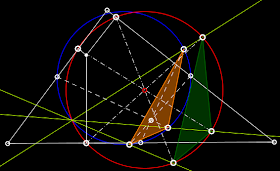domingo, 28 de diciembre de 2014
domingo, 21 de diciembre de 2014
Concurrence On The Nine-Point Circle (No proven yet)
Much more interesting than the particular case I proposed, is the generalization by Francisco Javier García Capitán at ADGEOM1280.
Given a triangle ABC and a point P. Call A1B1C1 be the circumcevian triangle of the complement of P with respect the medial triangle. Call A2B2C2 the triangle formed by the reflections of the vertices of the pedal triangle of P on the center of the pedal circle of P, that is the antipodes of the vertices of the pedal triangle on its circumcircle. The triangles A1B1C1 and A2B2C2 are perspective at a point Q on the nine point circle.
sábado, 20 de diciembre de 2014
Pólya on Mathematical Abilities.
Pólya interviewed by Jeremy Kilpatrick.
JK: How did you identify the students you had who were best in mathematics? You taught some students who were good in mathematics. How could you tell who were the best ones?
GP: Who was the best one, I can’t tell you.
JK: Well, among the best, how could you identify their talent? They were quicker?
GP: Anyhow, they asked good questions. So they found out something by themselves. And so on. There is no simple way—. You see, people are too different. Mathematicians are too different. There is no simple way of describing it. I don’t think so.
JK: What about people who are creative in mathematics as opposed to just being able to learn it? What does that take? What does that require? Just great interest?
GP: I don’t know.
JK: Not everyone could be creative in mathematics.
GP: I said somewhere, “What is the difference between productive and creative?” If you think about a problem, if you produce a result, then you are productive. If in working you get into a method with which you can solve also other problems, then you are creative. That’s the difference. And that is difficult to say. I don’t think there are obvious signs to recognize this. I don’t think so.


